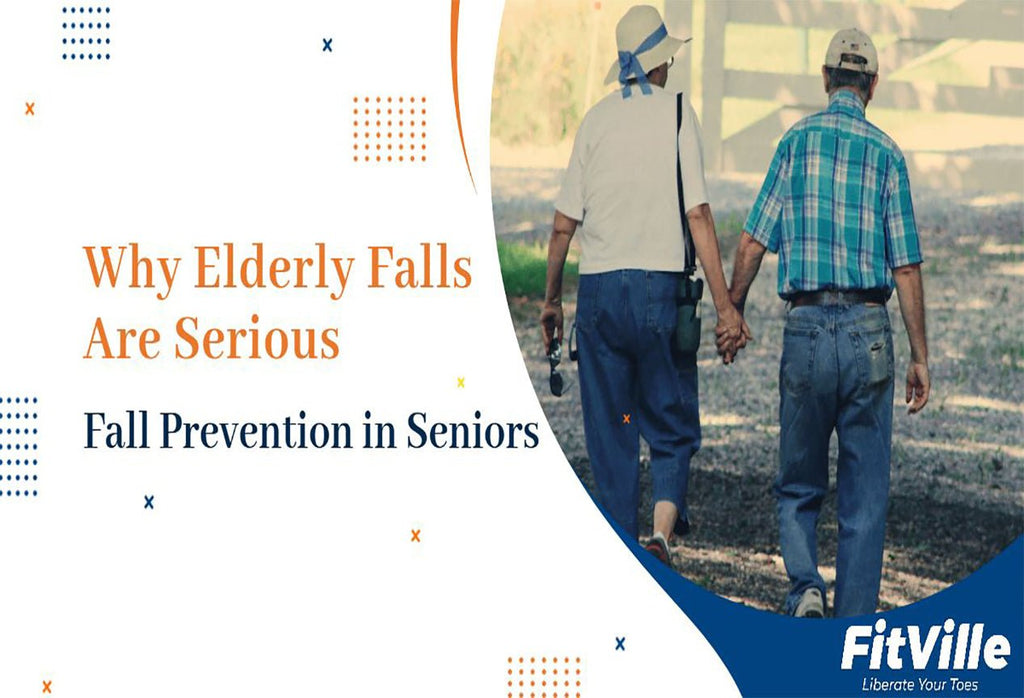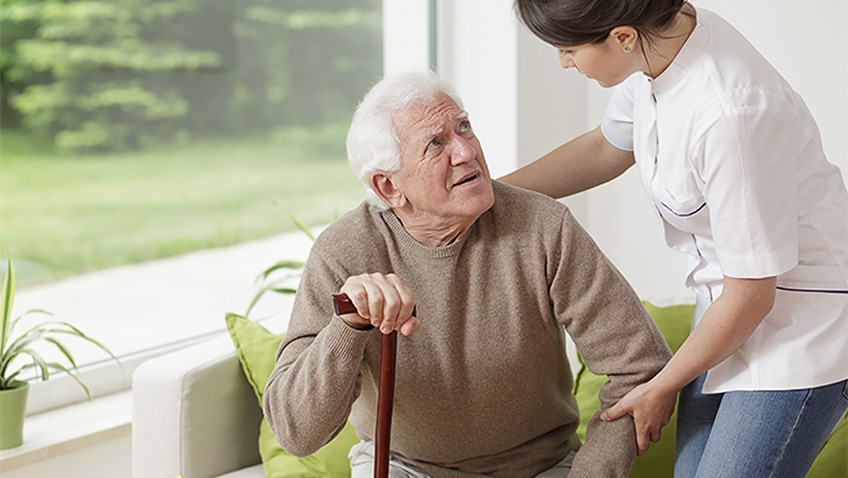Fall Prevention in Seniors: Why Elderly Falls Are Serious

For most people, a fall might seem like a minor mishap—something you quickly recover from and continue your day. However, when it comes to seniors, falls can have far more serious consequences. Fall prevention in seniors is critical because even a simple fall can result in broken bones, extended hospital stays, loss of independence, and potentially life-threatening complications. Moreover, the fear of falling again often restricts activity and mobility, which can accelerate physical decline and increase the risk of future falls.
Understanding why falls occur in older adults, recognizing the serious risks involved, and implementing effective fall prevention strategies, like getting a pair of Best Walking Shoes for Seniors, are essential steps to protect seniors and maintain their quality of life.

Key Factors for Fall Prevention in Seniors: Common Causes
Falls don't just "happen" by chance—especially in older adults. They are typically the result of multiple contributing factors, many of which are preventable through effective fall prevention in seniors. Understanding these common causes is essential:
Environmental Hazards
- Uneven flooring or slippery surfaces
- Dim lighting, particularly at night
- Bathrooms lacking grab bars or equipped with low toilets
- Obstacles such as loose rugs or cluttered walkways
Physical Factors
- Poor vision
- Reduced muscle strength and balance
- Slower reflexes
Medical Conditions
- Chronic illnesses like anemia, arthritis, Parkinson's disease, or history of stroke
- Dizziness or vertigo
Medications
- Blood pressure medications, sedatives, and diabetes drugs that may cause dizziness, drowsiness, or low blood sugar
- Polypharmacy—taking multiple medications—that can increase the risk of falls
Behavioral and Psychological Factors
- Refusal to accept help or use mobility aids
- Anxiety or fear of falling again, which can lead to stiffness or inactivity
- Growing dependence on others, resulting in decreased physical capability
By addressing these factors, fall prevention in seniors can be significantly improved, helping to reduce the incidence of falls and their serious consequences.

Why a Fall Can Be Devastating for Seniors
Falls are the leading cause of injury among older adults and can have serious consequences, including:
- Hip fractures requiring surgery and lengthy recovery
- Life-threatening head injuries
- Loss of mobility and independence, often leading to depression or social isolation
- Increased risk of recurrent falls, as fear restricts movement and weakens muscles
Managing Medication-Related Dizziness for Fall Prevention in Seniors
Certain medications commonly prescribed to seniors can cause dizziness, drowsiness, or confusion, all of which increase the risk of falls. Effective fall prevention in seniors includes managing these medication-related side effects carefully.
Common Medications That May Cause Dizziness:
- Blood Pressure Medications: Can cause orthostatic hypotension—sudden drops in blood pressure when standing.
- Sedatives: Such as benzodiazepines, which may lead to confusion or drowsiness.
- Diabetes Medications: Insulin or sulfonylureas can cause low blood sugar, resulting in shakiness or faintness.
- Polypharmacy: Taking multiple medications simultaneously raises the risk of drug interactions and side effects.
Strategies to Reduce Risk:
- Annual Medication Review: Regularly consult your doctor or pharmacist to adjust dosages, discontinue unnecessary drugs, or find safer alternatives.
- Report Symptoms Promptly: Notify healthcare providers if you experience dizziness, lightheadedness, or mental fog.
- Follow the Three Slow Rule: Stand up slowly to reduce dizziness upon rising.
- Minimize Medication Load: Discuss with your doctor about safely discontinuing any non-essential medications.
- Stay Hydrated and Nourished: Proper fluids and balanced diet help stabilize blood sugar and circulation.
Action Steps for Medication Safety:
✅ Schedule medication reviews with your healthcare provider
✅ Keep a daily log of dizziness or unusual symptoms
✅ Use a pill organizer to avoid missed or double doses
✅ Ask about safer medication alternatives
(Source: National Institute on Aging — www.nia.nih.gov)

How to Prevent Falls: Practical Tips for Fall Prevention in Seniors
The good news is that most falls are preventable. Seniors and their families can take meaningful steps to create a safer, more confident daily life:
1. Create a Safe Home Environment
- Keep floors dry and clutter-free
- Ensure proper lighting, especially at night (consider night lights)
- Place frequently used items within easy reach
- Install grab bars and non-slip mats in bathrooms
- Remove tripping hazards such as loose rugs and cords
2. Move With Intention: The "Three Slow" Rule
To reduce dizziness and prevent falls caused by sudden blood pressure changes (orthostatic hypotension), practice this simple routine:
- 🕒 Lie to Sit: Remain lying down for 30 seconds after waking
- 🕒 Sit to Stand: Sit on the edge of the bed for 30 seconds before standing
- 🕒 Stand to Walk: Stand still for 30 seconds before walking
This helps your body safely adjust to position changes.
3. Use Assistive Devices When Needed
Canes, walkers, and handrails are valuable tools for maintaining safety—not signs of weakness. Family members and caregivers should encourage and assist with their use, especially outdoors or on slippery surfaces.
4. Exercise Regularly
Gentle activities like walking, tai chi, or light stretching enhance balance, muscle strength, and coordination. Exercise also helps prevent osteoporosis, reducing the risk of fractures from falls.
5. Review Medications (Again!)
Medication management is a critical, yet often overlooked, part of fall prevention in seniors. Regular reviews with healthcare providers can help adjust or eliminate medications that increase dizziness or other fall risks.
Recommended Footwear: Why FitVille Shoes Are a Great Choice
One often overlooked but essential factor in fall prevention is proper footwear. Shoes like slip-resistant shoes that fit well, provide good support, and offer slip-resistant soles can make a big difference in stability and confidence.
FitVille Shoes are specially designed to meet the needs of older adults and those with sensitive feet, making them an excellent choice for fall prevention:
- Wide and Extra-Wide Options to accommodate swelling and foot deformities such as bunions or hammertoes.
- Ergonomic Memory Foam Insoles that provide cushioning and reduce foot fatigue during long periods of standing or walking.
- Slip-Resistant Rubber Outsoles with excellent grip on various surfaces to prevent slips and falls.
- Adjustable Straps for secure fitting and easy on/off, especially helpful for those with limited dexterity.
- Supportive Heel Cups and Arch Support to promote proper foot alignment and stability.
- Lightweight and Breathable Materials for all-day comfort and moisture control.
FitVille offers a variety of styles including walking shoes, diabetic-friendly shoes, and recovery sandals—each designed with safety, comfort, and support in mind.
Investing in a pair of FitVille shoes is a simple step toward safer mobility and reduced fall risk.

The Role of Family and Caregivers in Fall Prevention
Family support is vital in preventing falls among seniors. Here's how caregivers can help:
- Observe changes in posture, gait, or confidence
- Encourage the use of mobility aids without stigma
- Participate in light physical activities together to promote movement
- Help remove hazards and make simple home modifications
- Provide emotional support to reduce anxiety and boost confidence
Final Thoughts: Small Steps Lead to Safer Living
For seniors, a single fall can be life-changing—shifting independence to dependence. But with thoughtful planning, home safety improvements, medication management, and compassionate support, most falls can be prevented.
Fall prevention in seniors isn't about wrapping loved ones in bubble wrap—it's about empowering them to live actively, safely, and with dignity.
Start making small changes today. Help your loved ones rise safely, walk confidently, and age well.
Note: FitVille footwear is designed for comfort and support but is not intended for medical diagnosis or treatment. FitVille disclaims any responsibility for injuries or harm resulting from the use of this product.
About FitVille Footwear
Just Follow us on LinkedIn, Facebook, YouTube, Instagram, RSS feed and Pinterest to catch our brand news.
What FitViller Prefers
Best Shoes to Buy

Popular Men's Shoes

Popular Women's Shoes
































